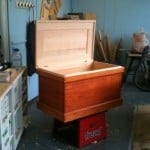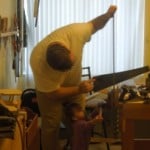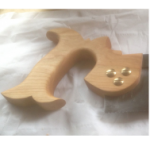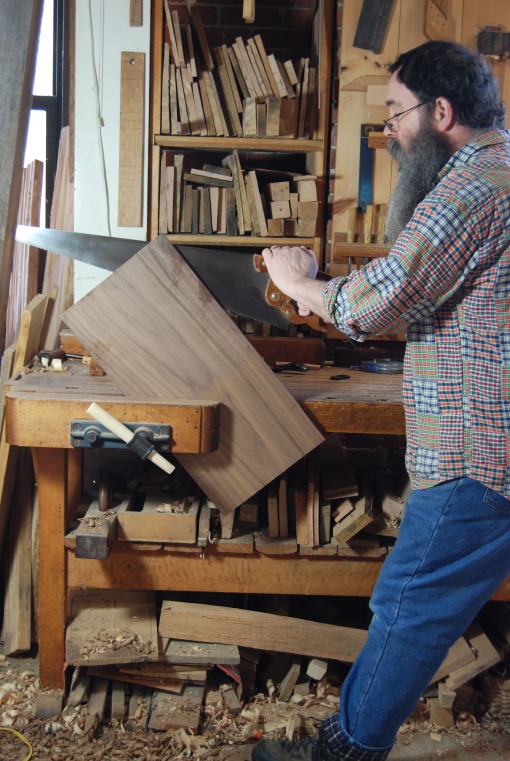board thickness
Welcome! / Forums / General Woodworking Discussions / Wood and Wood Preparation / board thickness
- This topic has 15 replies, 7 voices, and was last updated 10 years, 6 months ago by
Ken.
-
AuthorPosts
-


Hi and welcome aboard @David,
We discussed this issue about two months ago in this forum. These are the threads:
I hope this helps you. Best regards from Catalonia,
–Óscar

Hello Oscar and thanks for the welcome and for pointing me to these two threads. I think this might work well for smaller, thicker pieces of wood, but would anyone cut a larger 1″ board with this method? I plan to make a silverware drawer organizer. For the bottom, I want to use a 1/2″-3/8″ panel. Do I have to cut it from thicker stock? Do I have to use plywood? Can you go to your local wood supplier and get a 1/4x24x28 maple or ash panel?
Or is it only my ignorance, and you don’t use thin solid wood boards – apart from veneer – at all?

This is my technique for resawing thin boards from a chunck of wood using a frame saw (republished here in this format only for clarity):
First, set your marking gauge slightly more than your desired size (10 millimiters in this case)…
//http://cssmosaic.com/images/IMG-20130826-WA0036.jpg
Set your marking gaugeMark your gauge line along the both faces of your chunck of wood…
//http://cssmosaic.com/images/IMG-20130826-WA0037.jpg
Mark your gauge lineRun your line also across the grain in both sides…
//http://cssmosaic.com/images/IMG-20130826-WA0035.jpg
Run your line across the grainWith a chisel cut an small dent in the corner of your saw line…
//http://cssmosaic.com/images/IMG-20130826-WA0041.jpg
Cut a small dentThe magic begins now! Use an inexpensive frame saw to cut a perfect slice of wood following your vertical gauge mark. First, start at the front corner sawing until you reach the opposite corner…
//http://cssmosaic.com/images/IMG-20130826-WA0024.jpg
Using a frame sawNow saw vertically until you reach about the half of your block of wood. Then flip it and start from the oposite corner. Happily the two lines will meet…
//http://cssmosaic.com/images/IMG-20130826-WA0028.jpg
Using a frame sawThen you are here: your panel slide cuted exceptionally straight. The frame saw allows an easy control leveling your cut using both hands…
//http://cssmosaic.com/images/IMG-20130826-WA0030.jpg
Your thin panel cutI build this small frame saw two years ago based on an engraved of “L’Art du Menuisier” of Andre Roubo. Here you can see the artifact disassembled showing its parts. Very simple construction, very effective, and only costs me five bucks by the wide saw hack blade, the long carriage bolt and two small pins…
//http://cssmosaic.com/images/IMG-20130826-WA0023.jpg
The frame saw disasembledFinally, you only need to plane your piece to remove the saw marks using a thin face planing stop…
//http://cssmosaic.com/images/IMG-20130826-WA0031.jpg
Removing the saw marksFinish the surface with a smoothing plane and you are done.
//http://cssmosaic.com/images/IMG-20130826-WA0026.jpg
Smoothing your surfacesNOTE: Excuse my poor english and the low quality images.
Best regards from Catalonia,
–Óscar


Another method, much more traditional and ideal for practice of the hand tool techniques and get away from industry, is fill the back side of cupboards or bookcases with natural wood strips with a special joint, named “shiplap joint”. It’s very decorative and delicate and enhances absolutely your piece of furniture.
Anyway, for the bottom of your drawers, plywood is perhaps the most practical solution.
–Óscar
Attachments:
You must be logged in to view attached files.
I use aspen for my drawer bottoms. It’s a really cheap wood so I don’t mind buying 4/4 and planing it down to 1/2″. It’s also soft so it’s easy on the planer knives. Looks gorgeous and silky when hand planed too. It only comes in narrow widths so you have to join the panels together but that’s easy. Finally, it’s very light which is always a boon in drawer bottom construction.
Sorry I don’t have a better picture available.
Attachments:
You must be logged in to view attached files.
 28 October 2013 at 8:42 am #20452
28 October 2013 at 8:42 am #20452If I was doing board that wide make sure you cut from each side. I would say that 11″ a bit wide. 6″ about widest I would go if only 1/4″ thick I would prefer 4″ and glue edges together woul be more stable.

Hi @Brandon, really it’s a mixture of tool condition and technique.
You can use a regular panel saw to do this work but, definitely, for a wide cut like this, you need a large and sharpen rip saw with a configuration of 4 to 7 TPI and the appropriate set. I recommend use a marking gauge to set the path of the saw around the plank to cut. This is not a really difficult work but something tedious. Remember, this was done over centuries by our ancestors who obviously had no band saws.

Personally, I use frame saws for this kind of work for various reasons: mine is lightweight, so i’m just less tired, second, my cuts tend to be next to perfect to the line, and finally, if the work needs it, another person can help me pushing from the another side of the saw. But this is only my personal preference.

TIP: Greasing o waxing the saw plate during the process will facilitate the job.
TIP2: When the saw blade sinks into the cut, put a pair of small wedges on the kerf to prevent the saw runs aground inside the board.
Best regards from Catalonia,
–Óscar

@Ken, the real expert on the subject is Bob Easton, who in this modern days resawed by hand a board of sixteen foot. He documented their feat in his blog:
Obviously, he used a frame saw 😉
I think he is member of this forum too.
–Óscar
 28 October 2013 at 12:13 pm #20457
28 October 2013 at 12:13 pm #20457David
I do not know what is available in Germany but here in UK my local timber merchant has sawn and planed me 1/2″ and 1/4″ boards for making Paul’s dovetail boxes -
AuthorPosts
- You must be logged in to reply to this topic.
